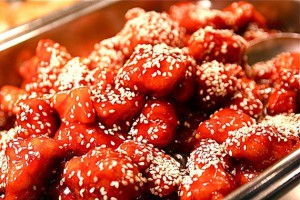For many Jewish Americans, the night before Christmas conjures up visions, not of sugar plums, but plum sauce slathered over roast duck or an overstocked plate of beef lo mein, a platter of General Tso’s, and (maybe) some hot and sour soup.
For many Jewish Americans, the night before Christmas conjures up visions, not of sugar plums, but rather plum sauce slathered over roast duck.
Jews and Chinese food are as much a match of necessity as sweet and sour are, is only half the wonton. The circumstances that birthed Jewish Christmas are also deeply historical, sociological, and religious.
The story begins during the halcyon days of the Lower East Side where, as Jennifer 8. Lee, the producer of The Search for General Tso, said, “Jews and Chinese were the two largest non-Christian immigrant groups” at the turn of the century.
So while it’s true that Chinese restaurants were notably open on Sundays and during holidays when other restaurants would be closed, the two groups were linked not only by proximity, but by otherness. Jewish affinity for Chinese food “reveals a lot about immigration history and what it’s like to be outsiders,” she explained.
Estimates of the surging Jewish population of New York City run from 400,000 in 1899 to about a million by 1910 (or roughly a quarter of the city’s population). And, as some Jews began to assimilate into American life, they not only found acceptance at Chinese restaurants, but also easy passage into the world beyond Kosher food.
“Chinese restaurants were the easiest place to trick yourself into thinking you were eating Kosher food,” Ed Schonfeld, the owner of RedFarm, one of the most laureled Chinese restaurants in New York, said. Indeed, it was something of a perfect match. Jewish law famously prohibits the mixing of milk and meat just as Chinese food traditionally excludes dairy from its dishes. Lee added:
If you look at the two other main ethnic cuisines in America, which are Italian and Mexican, both of those combine milk and meat to a significant extent. Chinese food allowed Jews to eat foreign cuisines in a safe way.
And so, for Jews, the chop suey palaces and dumpling parlors of the Lower East Side and Chinatown gave the illusion of religious accordance, even if there was still treif galore in the form of pork and shellfish. Nevertheless, it’s more than a curiosity that a narrow culinary phenomenon that started over a century ago managed to grow into a national ritual that is both specifically American and characteristically Jewish.
Over the centuries, different religious customs have sprung up and new spiritual rituals have taken root, many of which draw on the past. Jewish Christmas, in many ways, could very much be seen as a modern affirmation of faith. After all, there are few days that remind American Jews of their Jewishness more than Christmas in the United States.

